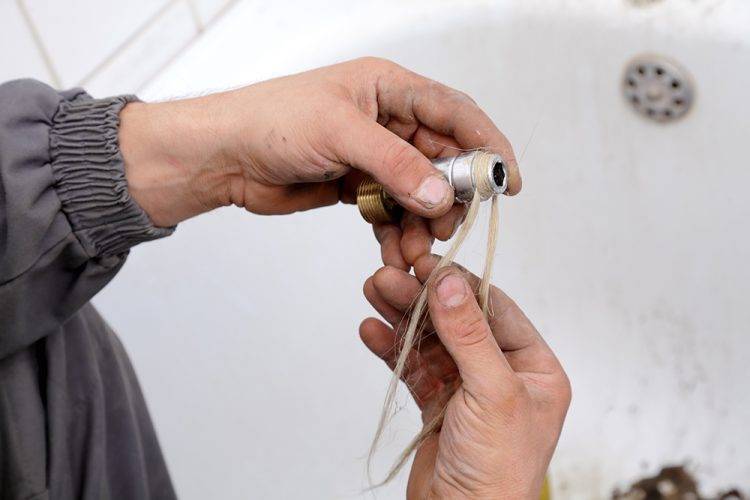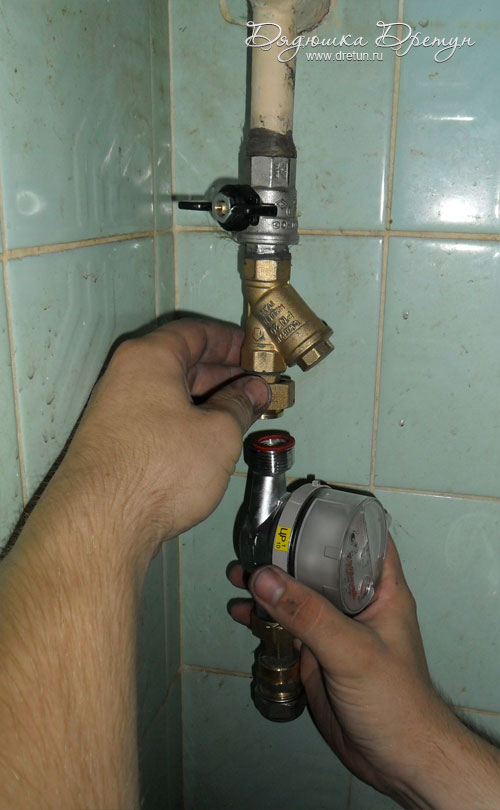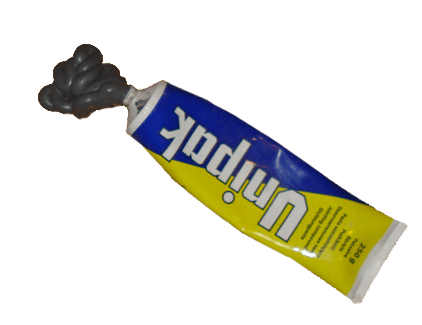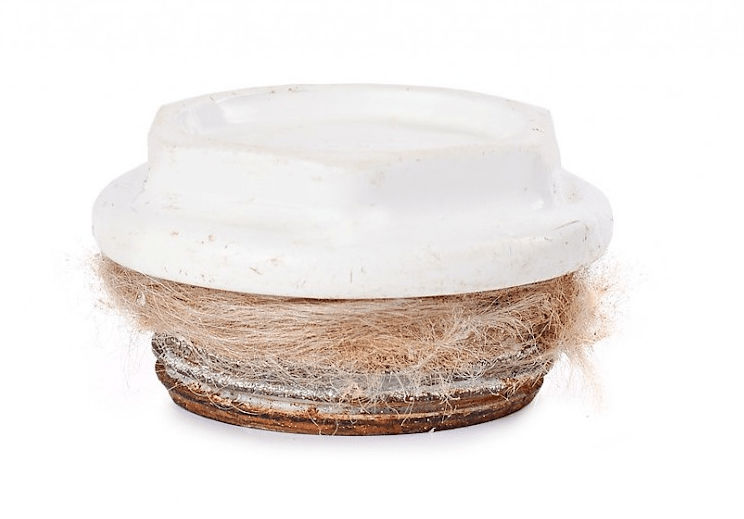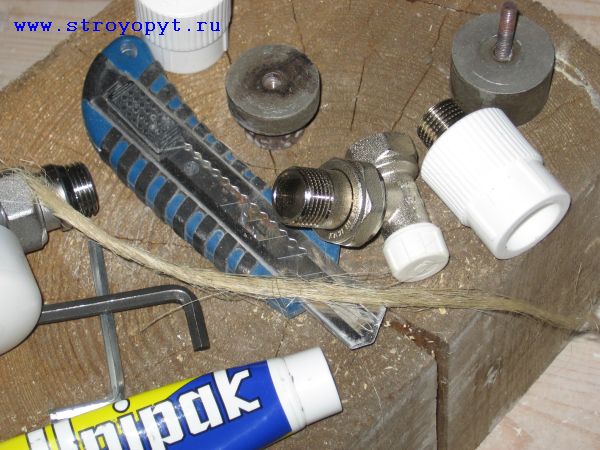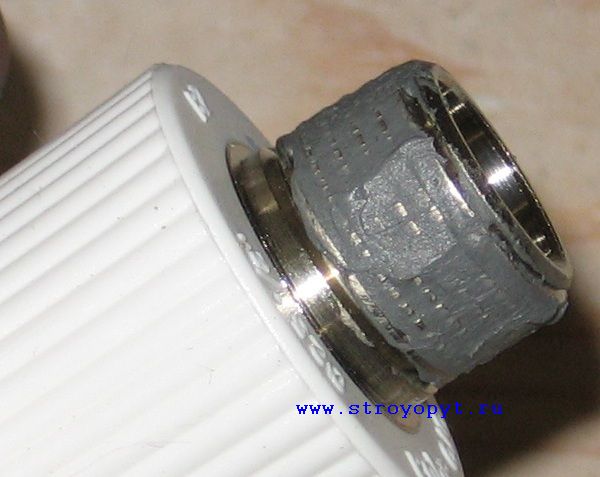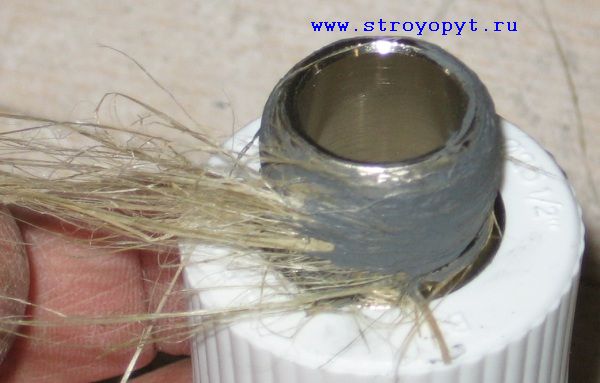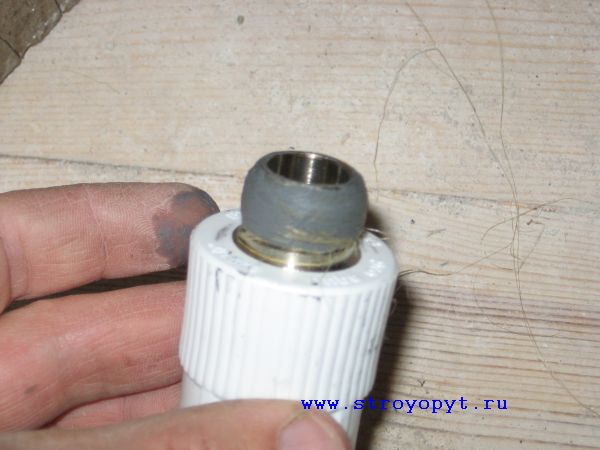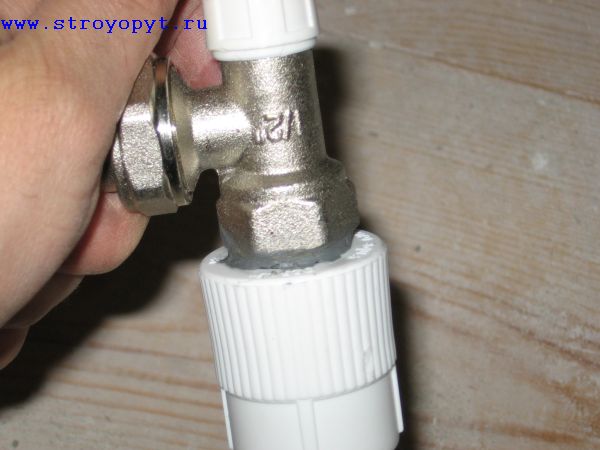What sealants does the building materials market offer?
There are several types of sealing materials that differ in cost, convenience and reliability of use:
- FUM tape (fluoroplastic sealing material)
- Sealing thread
- linen thread
Among all the FUM offers, the tape is rather capricious in application, the sealing thread has good qualities, but is too expensive, and only flax is an impeccable tool that has proven itself over many decades.
How to wind flax on a thread?
In order for the connection to be strong and tight, the threaded areas must be cleaned of rust with fine-grained sandpaper.
At this stage, it is important not to damage the threads. Then you should check if there are notches on the thread - with them the laid flax threads are fixed and do not move when the parts are connected
If there are no notches, they can be applied with a file or a plumbing wrench.
The correct winding of flax consists of several steps:
Check the tightness of the connection with a clean, linen-free thread in order to understand how thick the winding should be.
Take a bunch of flax and separate a strand of sufficient thickness from it to obtain a tight connection. Flax hairs should be of the same length, without lumps, straw and debris.
Twist from a strand a loose tourniquet of such a thickness that it can fill one groove of the thread.
Holding the end of the linen tow at the edge of the thread, wind it in the direction opposite to the tightening of the nut. Each subsequent turn should fit snugly to the previous one.
It is important here not to overdo it with the number of layers, there should be no more than two, otherwise the connection may burst when twisted or from hot water during operation. If the bundle turned out to be short, the winding should be continued with the next bundle.
Inspect the reverse side of the winding and make sure there are no bald spots.
Apply a layer of special paste or silicone on top of the linen and twist the connection until the paste has hardened
The use of a sealing compound contributes to the durability of the connection, prevents rotting of the flax, and helps to easily disassemble the structure in the future. Sealant should not be used as a sealant, such a connection is difficult to disassemble.
The use of a sealant in threaded connection of piping systems is simple. This approach does not require the use of expensive equipment, and can be easily performed by both a professional and a home plumber.
1. Appointment of tow and how it works.2. Varieties of sealing materials.3. Method for sealing pipe threads with tow.
In plumbing work, tow is used to seal pipes and transitions connected by threads. It is made mainly from flax waste and is a coarse fiber of small size. If the tow is wound correctly, leakage protection will be provided throughout the life of the pipeline. Answering the question of how to wind tow on a thread, it should be said that the quality of workmanship prevents the risk of a leak in the plumbing system. There is a gap between the threaded connections through which water freely exits the pipeline. If there is a properly laid plumbing tow in it, then the gap becomes smaller, and in the process of water penetration into such a connection, the flax swells and the leak stops.
The procedure for winding sanitary tow
How to wind tow on a thread? Before winding the tow, it is necessary to pre-prepare the thread. Since the surface of the thread is most often flat, the winding will begin to slip and bunch up. And sealing is not possible.The thread must have notches, thanks to which the fibers can catch on the threaded surface. The winding will not slip and will provide high-quality sealing.
You can make such notches or notches with a file or needle file. If you do not have these tools, then you can use pliers. With the help of them it is necessary to squeeze the thread in a circle. But it is better to purchase a thread on which manufacturers have already made notches.
Then a strand of fibers must be separated from the pigtail. Choose a strand that will fit in thickness. The material should not be too thick, but not too thin. The strand of fibers should not have lumps. If there are lumps, they must be eliminated. The winding process can take place in different ways.
Many specialists twist the product before winding, others braid thin pigtails, and some wind it loose. It depends on the person himself. The overall result will be the same.
How to wind tow correctly? In any chosen option, the winding of the turns is carried out in the direction of the thread. Outside the thread, the end of the strand of fibers must be clamped with a finger. The first turn is applied in the form of a "lock". Be sure to wind the strands tightly, do not leave gaps. As the winding is completed, the strand of fibers must be glued to the companion product closer to the extreme part of the thread. The winding of the tow on the thread is done crosswise.
These are the most common and popular methods for sealing threaded connections. All of them are great, but you need to follow certain rules and nuances.
How to wind
everything is very simple. The main thing is not to be afraid and not to overdo it. The bottom line is this: Wrap too much, the connection may burst, if too little, it may also leak.
How to use Unipack? The manufacturer recommends smearing the paste on the cleaned thread, then we wind the flax and on top another layer of Uniate.
We smear only on top, and sometimes I just smear the whole strand with unipack and then wind it on the thread.
The most important thing is that it is necessary to wind the flax so that it does not unwind when twisting. On a regular thread, wind clockwise
When twisting the product, linen will not unravel. And so, let's go:
Wound and applied unipack? Now we twist.
Most importantly, do not wind too much so that the fitting does not crack.
This connection must be conscientiously pulled together with two keys. And this can be the end. Let's move on to the next connection.
For sealing connections, you need to use a choice of:
1. Linen + sanitary paste.
Flax is not suitable for temperatures above 90 degrees, it boils over time, burns out, loses its properties.
2. TANGIT Uni-Lock or equivalent.
Tangit unilok is more expensive than analogues, 20 meters Tangit unilok (a package on a blister, on which it is written that it is enough for 50 connections for a 1/2 inch thread) costs 130 rubles, and an analogue - "Plumbing" 50 meters costs the same 130 rubles ( in Leroy-Merlin, St. Petersburg).
3. Polyamide thread + silicone grease.
On the packages of Tangit unilok and analogues, the composition is written: polyamide thread + silicone. If we want to save money, then we conclude: you can buy an ordinary thick thread of polyamide in a hardware store or in a sewing store and buy thick or liquid silicone grease in auto parts or the same plumbing paste.
4. Linen rope + plumbing paste.
Household linen, jute and similar ropes made from vegetable raw materials are sold in construction and hardware stores. They cost about 50 rubles. for 50 meters.
Silicone sealant is not suitable because it polymerizes / hardens and if you need to position the connection, say after a few hours, then it will break inside the thread. Therefore, a sealing filler that does not harden and does not wash out should be used. In addition, acetic-based silicone sealants can be corrosive to metals.
In general, in order to understand which is better, you just need to experiment.
How to wind? Crosswise, as indicated in the instructions for Tangit unilok, either threaded or against threaded - it's all a matter of habit. The main thing is to wind tightly so that the thread is closed with the material used. I will wind it this way and that, and nothing will come out of the thread and nothing will flow. But still, a thread or linen wound against a thread will be cut faster when the nut is tightened, this is obvious.
Winding different materials for 1/2" thread:
1.
We take flax, smooth it, trim a strand with a thickness of one, maximum two matches.
We smooth the separated strand again, holding it between the fingers, we throw out the small villi.
If desired, you can twist the strand into a lace.
We wind it very tightly along the thread, starting from the edge so that the thread groove is completely closed.
Then we take the plumbing paste and spread a small amount with rotational movements on the wound linen.
If your hands grow from the right place, then everything should turn out very carefully.
Then we twist the connection, twisting should occur with a certain effort, but not with all the dope!
If the nut is twisted easily, then there is little flax, or there is too much clearance between the internal and external threads. It is necessary to unwind the linen and wind up a new one in a larger quantity.
If everything is done correctly, then linen should not come out from under the thread and it will be dry :)
2.
The thread Tangit unilok is wound along the thread or crosswise 6-8 turns and connected. And everything.
3.
Self-made option. We also wind the polyamide thread and coat it with sanitary paste or thick silicone grease. Or, first, the entire skein of threads is abundantly impregnated with liquid silicone grease. We wind on the connection. We connect. And that's it.
If you soak or soak a skein of thread in a liquid lubricant, then you need to put it in some small plastic box or bottle so that dirt does not stick to the thread and it does not stain anything.
4.
We separate the linen rope into two laces, from which it is twisted. We cut off 40-50 cm. We wind it on the thread. Lubricate with sanitary paste and tighten the connection.
Synthetic thread - Tangit unilok or analogue - is the most versatile!
True knowledge will come only with experience!
Varieties, alternatives and selection rules
Flax is good at laying almost all metal pipes, including cast iron, stainless steel, non-ferrous metals, including copper, as well as their alloys such as brass. The only exceptions are aluminum and metal-plastic products, as well as those made from polymer compositions. For them, professionals recommend using fum tape.
On sale there are fibers of various qualities. All of them are made on the same equipment - a carding machine. They are distinguished by the numbers that contain the description on the label. They vary in the range from 8 to 24. At the same time, fibers with a higher number will have fewer impurities and vice versa. They are also characterized by a degree of flexibility, which is of lesser importance in work.
Fibers are packaged in coils, as well as pigtails of a fixed weight and size. Their color can vary from white to light gray, as well as beige due to the use of natural raw materials.
How to wind flax on a thread
Hello dear DIYers.
Until now, linen has been the best winding for carving. First, I will substantiate this statement, and then we will analyze the execution process piece by piece.
The first alternative to linen is fum tape. There are at least three reasons why it should be abandoned.
1. It is not known who made it, despite what is indicated on the label, which means there are no quality guarantees.
2. It takes a long time to wind it.
3. When tightening the thread, especially when installing valves, it is impossible to correct its position, that is, you can only twist it forward.If you apply a little back, then the connection on the fumka will flow.
The second alternative is the Tangit unilok pipe with a lock. I won’t argue about the lock - it’s dead, but as for the key: consider that they twisted it, and threw the key away, so you can’t find it.
You can't unscrew it, just cut it.
Linen is a completely different matter.
Disadvantages, negative points
Despite the large number of advantages, natural sealant is not without its drawbacks. They are especially evident in violation of the technology of installation and repair. After a short period of operation, rust may form at the joints, making it difficult to dismantle the structures during subsequent repairs. In view of this, it is recommended to regularly inspect the connections for leaks, and take measures to eliminate damage.
The material is very sensitive to the quality of work, so it is recommended to use it only for experienced craftsmen.
Attractive physical properties are offset by the low chemical sensitivity of the material. So, flax fibers will be destroyed under the influence of antifreezes if they are part of a mixture that goes through connected communications.
How to wind flax on a thread
And the paste also, of course, stains, but it is washed off with soap without any problems. Flax + paste sets are often sold in stores as a set in one package. Well, you can also buy them separately.
So let's get started. To begin with, I rolled up such a flagellum from flax:
Then he coated the thread with a thin layer of paste. I smeared it directly with my finger (this is a combination coupling, on which control valves were screwed to connect radiators):
After that, he began to wind a flagellum of flax on the thread, sinking it into the threads, trying to get the flax fibers smeared in the paste. When the second turn began, it was additionally smeared on top with paste as it was wound.
As a result, this is what happened:
Only Unipak used the paste. There was another one in the store, I don’t remember what brand, half the price, but for some reason I didn’t dare to buy it. The entire heating system took less than two small tubes of 65 grams! And I did not save it, I spent as much as needed.
Each radiator is 3 1/2" threaded connections. There are 8 radiators in total, 24 connections in total.
2 plugs and 2 Americans for a gas boiler with a 1 1/2 (one and a half) inch thread. Total 4 connections
Electric boiler: 2 adapters from 1 1/2" to 1 1/4" threads + two American 1 1/4. Total 4 connections.
Two connections per dirt filter - 1 inch
Two connections per circulation pump - 1 inch.
And the little things - pressure gauge, safety valve, expansion tank, what else. That seems to be all.
On small threads (1/2 inch) paste is consumed very little, just a few drops. The main expense was for boilers, a filter, a pump, where the thread is from an inch or more.
The summary is this: working with flax and pasta is easy and convenient.
And the fact that your hands get dirty, and if you grab a white polypropylene pipe, then the pipe is nonsense. Hands are washed with soap, the pipe is simply wiped with a cloth.
You can put your rating by clicking on the corresponding arrow:
